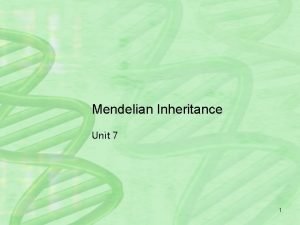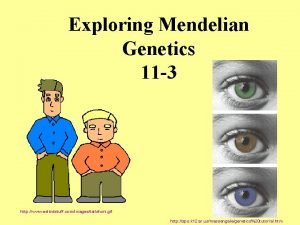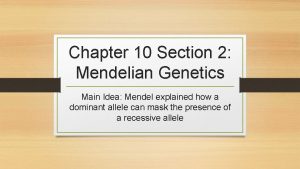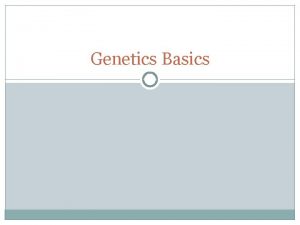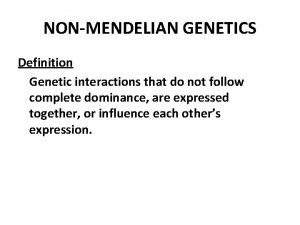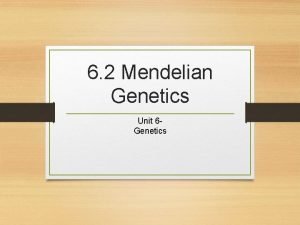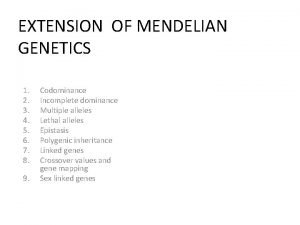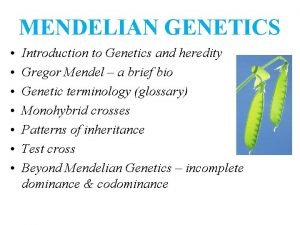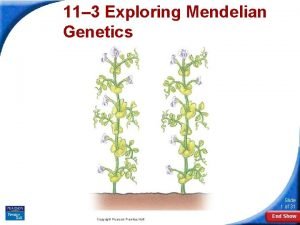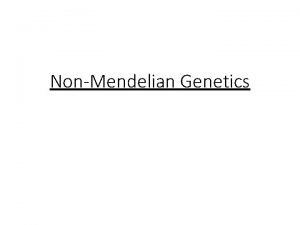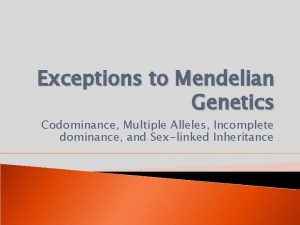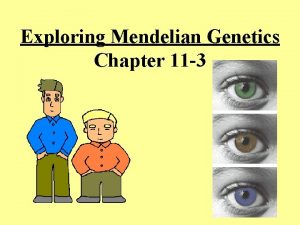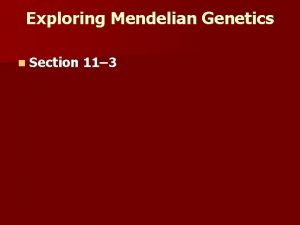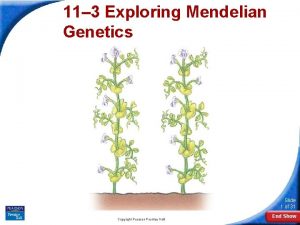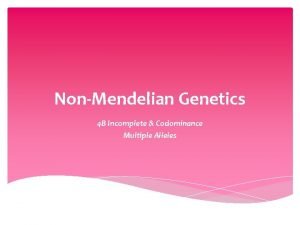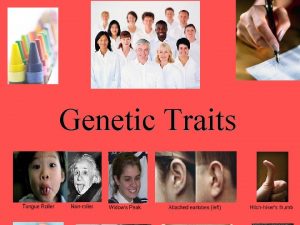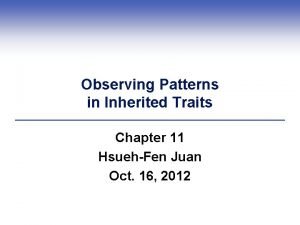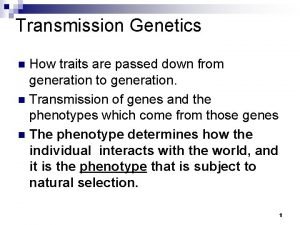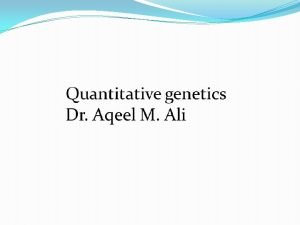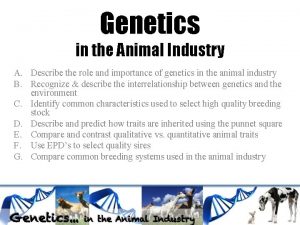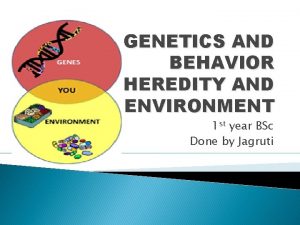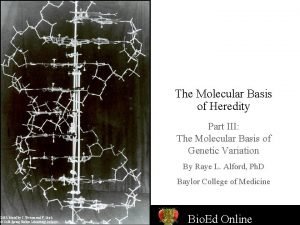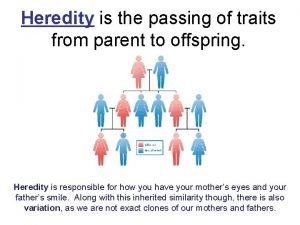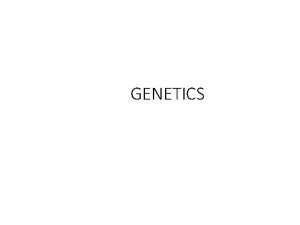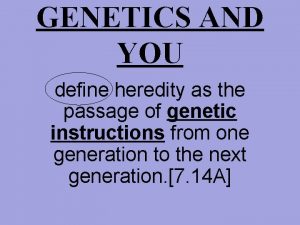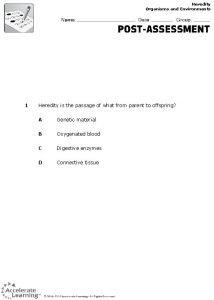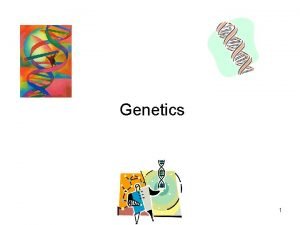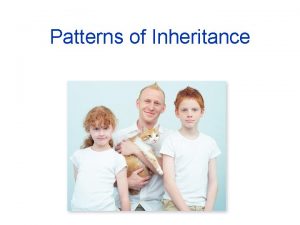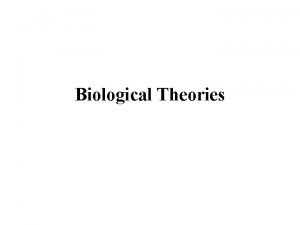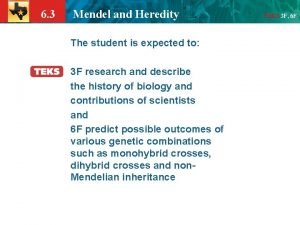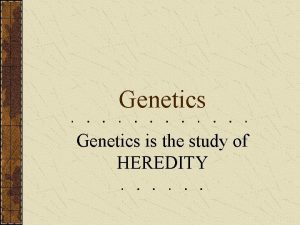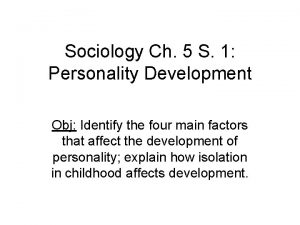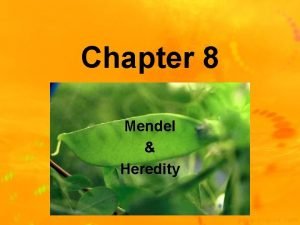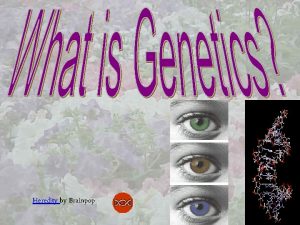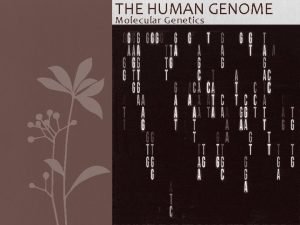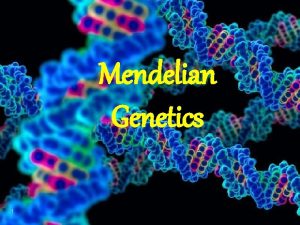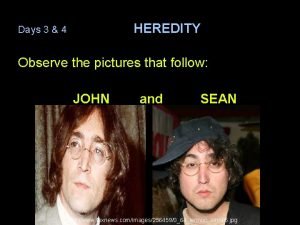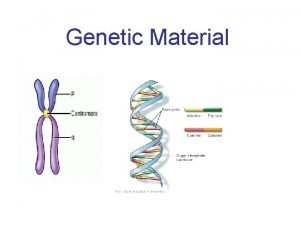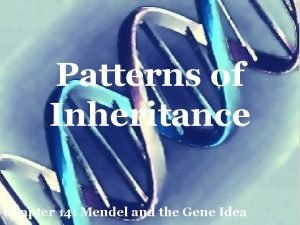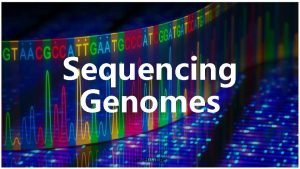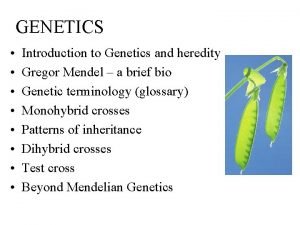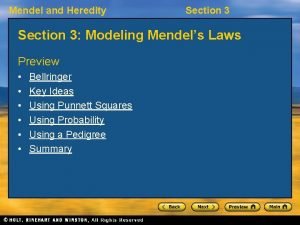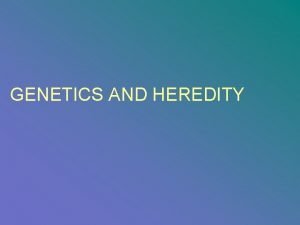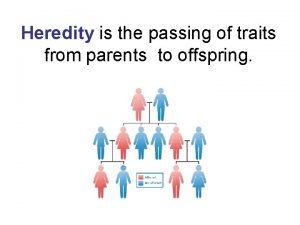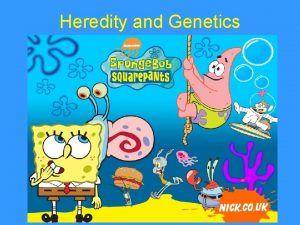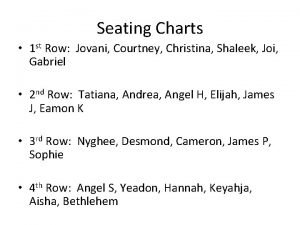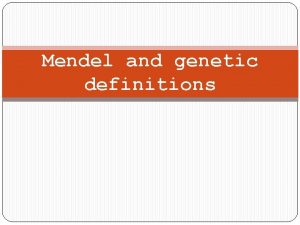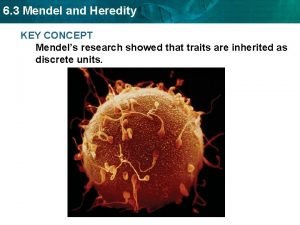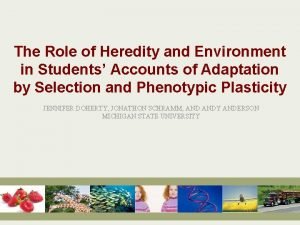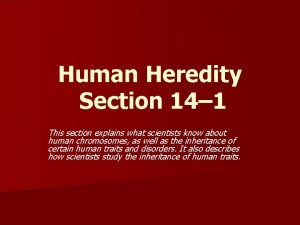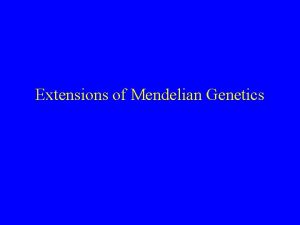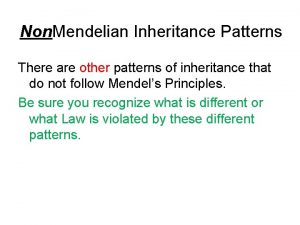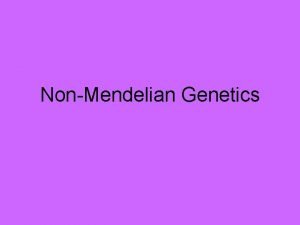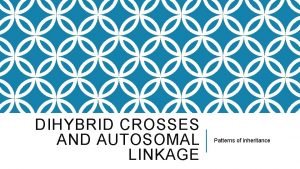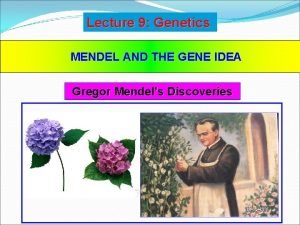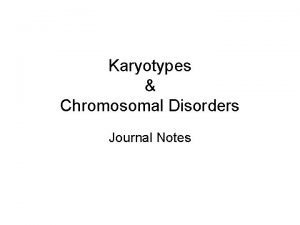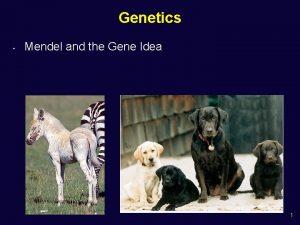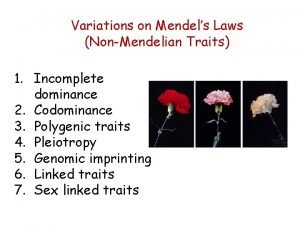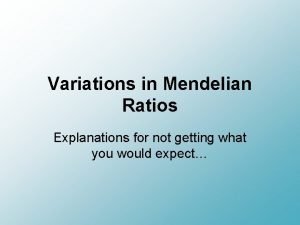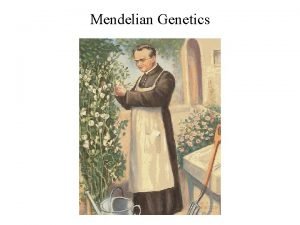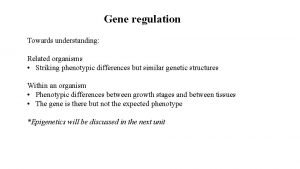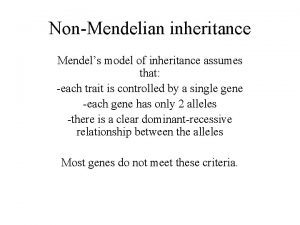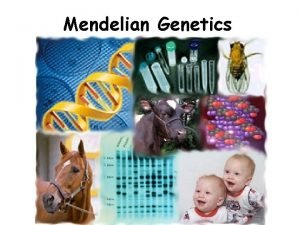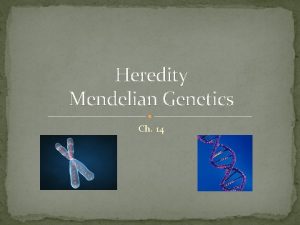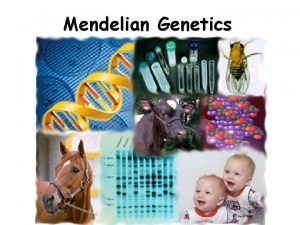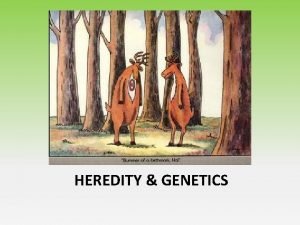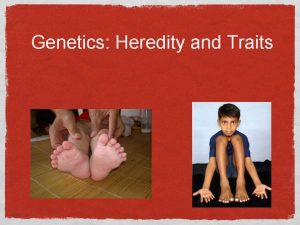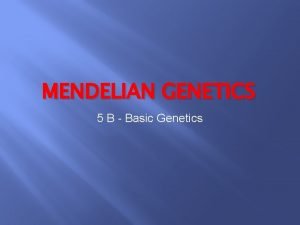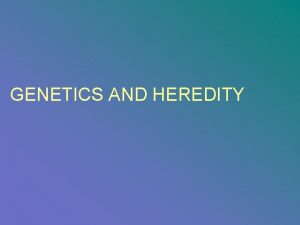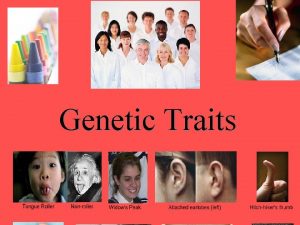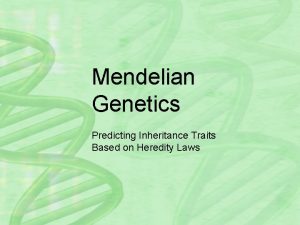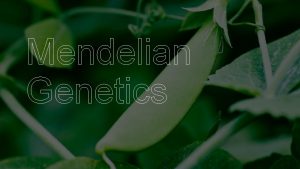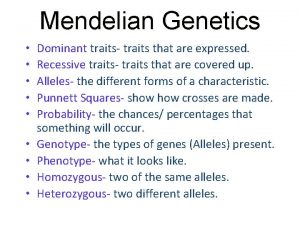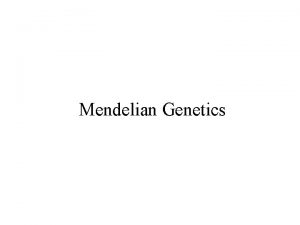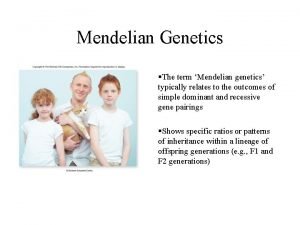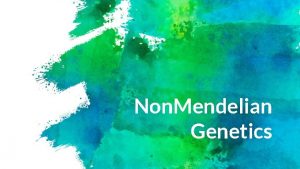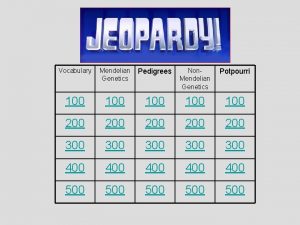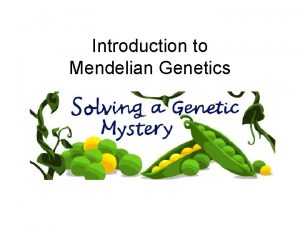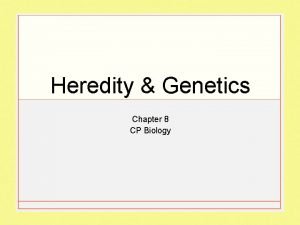Mendelian Genetics Heredity is the transmission of traits

































































































- Slides: 97

Mendelian Genetics

• Heredity is the transmission of traits from one generation to the next. • Genetics is the scientific study of heredity.

History of Genetics Ancient roots People wondering why/how parents and offspring were similar Hippocrates (460 BC) predicted particles called ‘pangenes’ from different parts of the body moved to the sperm and egg characteristics acquired during the parents’ lifetime could be transferred to the offspring Ex. Limp, crooked nose, scar (he was wrong on this last part…)

Gregor Mendel – Father of Genetics Austrian Monk 1822 -1884 Strong math and science background at University of Vienna Studied pea plants in the abbey garden

Gregor Mendel – Father of Genetics 1866 – he correctly argued that parents pass on to their offspring discrete “heritable factors” (today called genes) Character - A heritable feature that varies among individuals, such as flower color. Trait - Each variant for a character, such as purple or white flowers

Why the Pea Plant? A (others are fruit flies, rats, mice, chimps) great ‘model organism’ – means it can be studied easily and controlled Small number of easily observable traits Large numbers of off spring Short reproductive cycle

Why the Pea Plant? Perhaps the most important advantage of pea plants as an experimental model was that Mendel could strictly control mating. The petals of the pea flower almost completely enclose the reproductive organs: the stamens and carpel.

Good Research – Controlling variables Mendel Cross chose the specific parent plants fertilized plants with different traits prevented self-fertilization by cutting off the immature stamens of a plant before they produced pollen dusted its carpel with pollen from another plant to cross-fertilize the stamenless flower.

Figure 9. 2 c-2 1 Stamen removal Parents (P) Carpel 2 Pollen transfer Stamens 3 Carpel matures into pod

Figure 9. 2 c-3 He controlled the parent plants 1 Stamen removal Parents (P) Carpel 2 Pollen transfer Stamens 3 Carpel matures into pod 4 Seeds from pod planted So he could observe the effects on the offspring Offspring (F 1)

Write down 5 new terms from this video


Some Key Terms True-breeding varieties result when self-fertilization produces offspring all identical to the parent. Hybrids - The offspring of two different varieties. Genetic cross – aka hybridization, when there is cross fertilization between two parent plants P generation - True-breeding parental plants F 1 generation - Hybrid offspring from a cross of P generation plants. F 2 generation – the offspring from a cross of F 1 plants. Fix this on your sheet!

Some images to go with the previous terms…

True breeding – will always produce purple (or whatever variation the trait is, it could be white)

A genetic cross between two different parents The hybrid offspring

P generation (true-breeding parents) Purple flowers F 1 generation White flowers All plants have purple flowers Fertilization among F 1 plants (F 1 × F 1) F 2 generation 3 4 1 of plants 4 have purple flowers have white flowers

New notes sheet needed.

Mendel’s Law of Segregation Mendel did many crosses between two parent plants to determine the outcome. He focused on one character at a time flower color, or seed shape, or seed color, etc. A cross between two individuals differing in a single character is a monohybrid cross.

Mendel performed a monohybrid cross between a plant with purple flowers and a plant with white flowers. Both parents are true breeding! So if self-pollinated, the offspring would only produce offspring of one color He repeated this thousands of times and compared different traits.

Mendel’s Law of Segregation The all-purple F 1 generation did not produce light purple flowers, as predicted by the blending hypothesis (where the colors would blend together). Mendel needed to explain why white color seemed to disappear in the F 1 generation why white color reappeared in one-quarter of the F 2 offspring. He repeated his experiments thousands of times to get accurate data.

Mendel’s Law of Segregation Mendel continued crossing plants and come up with 4 hypotheses. 1. Alleles are alternative versions of genes that account for variations in inherited characters. Ex. White or Purple gene, round or wrinkled gene, tall or dwarf gene

Mendel’s Law of Segregation 2. For each character, an organism inherits two alleles, one from each parent. The alleles can be the same or different. (Often shown with letters) A homozygous genotype has identical alleles. - both white (pp), both purple (PP) A heterozygous genotype has two different alleles. - one white and one purple

Mendel’s Law of Segregation 3. If the alleles are heterozygous then the one that determines the organism’s appearance is called the dominant allele. The other has no noticeable effect on the organism’s appearance and is called the recessive allele. Purple (P) is dominant White (p) is recessive

Mendel’s Law of Segregation The phenotype is the physical appearance or expression of a trait. White The or purple genotype is the genetic makeup of a trait. PP, Pp, or pp

Mendel’s Law of Segregation 4. A sperm or egg (haploid) carries only one allele for each inherited character because allele pairs separate (segregate) from each other during the production of gametes (meiosis). This statement is called the law of segregation. The fusion of gametes at fertilization creates allele pairs once again (a diploid zygote).

The Explanation P generation Genetic makeup (alleles) Purple flowers White flowers pp PP What are the parent’s phenotypes? What are their genotypes? Gametes All p All P F 1 generation (hybrids) Pp Alleles segregate What is the F 1 generation phenotype and genotype? Gametes 1 2 P Fertilization F 2 generation What is the F 2 generation phenotype and genotype? Results: p Sperm from F 1 plant P Phenotypic ratio 3 purple : 1 white Genotypic ratio 1 PP : 2 Pp : 1 pp Eggs from F 1 plant P PP Pp pp Results p


Punnett Square A Punnett square shows the four possible combinations of alleles that could occur when gametes combine.

Punnett Square Designate a capital letter for the dominant allele and a lowercase letter for the recessive allele. Try to choose letters where the capital and lowercase letters are easy to distinguish ex. T – t E–e D–d not O–o Try a cross between the genotypes Dd and dd D d d Dd dd Z–z X - x

Try all these crosses: AA Tt Ee gg yy x x x aa Tt ee Gg YY

Ratios A ratio is the relationship between two or more quantities of something, written as ___: ___ or ___ to ___ We can show the ratio of the Punnett Square results The genotype ratio of this Punnett Square example is: 1 Dd: 1 dd D d d Dd dd

AA x aa If ‘A’ is dominant for axial and ‘a’ is recessive for terminal, what are the ratios for genotypes and phenotypes?

Tt x Tt If ‘T’ is dominant for tall and ‘t’ is recessive for dwarf, what are the ratios for the genotypes and phenotypes?

yy x Yy If ‘Y’ is dominant for yellow and ‘y’ is recessive for green, what are the ratios for the genotypes and phenotypes?

Mr. Johnson flips a coin five times. Each time, it lands on ‘tails. ’ He concludes that the coin will land ‘tails’ 100% of the time in the future as well. Is this a valid conclusion? Why or why not?

Take a coin and flip it ten times. Make your personal conclusion based on your data, then add your data to the class data and we’ll make a conclusion based on the whole class. Ex. If your results were 3 heads and 7 tails, your conclusion would be that 30% of the time it is heads and 70% of the time it is tails.

Excel file

If Mendel did his experiments 10 times, could he make significant conclusions?

If Mendel did his experiments 10 times, could he make significant conclusions? No, which is why he repeated his experiments thousands of times for multiple different characters (seed shape, flower color, seed color, etc. )

Probability Mendel’s laws reflect the rules of probability and a large amount of data is necessary to analyze the results and make accurate conclusions

A locus (loci) is the specific location of a gene along a chromosome. For a pair of homologous chromosomes, alleles of a gene reside at the same locus.

Dihybrid crosses A dihybrid cross is a mating of parental varieties that differ in two characters. P generation: round yellow seeds wrinkled green seeds What is the genotype of each parent if… R = round and Y = yellow




***Dihybrid crosses*** A dihybrid cross is a mating of parental varieties that differ in two characters. P generation: round yellow seeds wrinkled green seeds

Dihybrid crosses Mendel made two hypotheses. Either… The alleles would be inherited together like they were in the P generation (RY and ry) – dependent of each other The alleles would be inherited independently. R could be with Y or y. He tested it to see.

Figure 9. 5 a-3 F 1 generation Rr. Yy Sperm 1 4 1 4 1 4 r. Y 1 4 Ry 1 4 ry RY RRYY Rr. YY RRYy Rr. Yy r. Y Rr. YY Eggs 1 4 RY rr. YY Rr. Yy rr. Yy Results: Phenotype 9 16 3 16 Ry RRYy Rr. Yy RRyy rr. Yy Rryy ry Rr. Yy rryy The hypothesis of independent assortment Actual results; hypothesis supported 3 16 1 16 Yellow round Green round Yellow wrinkled Green wrinkled

Law of Independent Assortment A pair of alleles segregates independently of other pairs of alleles during gamete formation

Figure 9. 16 -1 -2 F 1 generation R r y All yellow round seeds (Rr. Yy) Y R r Y y r r Two equally probable y Y arrangements of chromosomes at metaphase I Anaphase I R r Y y Metaphase II R y r R Y y

Figure 9. 16 -1 -3 F 1 generation R r y All yellow round seeds (Rr. Yy) Y R r Y y r r Two equally probable y Y arrangements of chromosomes at metaphase I Anaphase I R r Y y Metaphase II R Meiosis I y r R Y y Meiosis II Gametes Y y Y R R 1 4 RY r y Y Y r r r 1 1 4 ry 4 r. Y Fertilization among the F 1 plants F 2 generation 9 : 3 : 1 y y R R 1 4 Ry

F 1 generation Rr. Yy Sperm 1 4 1 4 1 4 r. Y 1 4 Ry 1 4 ry RY RRYY Rr. YY RRYy Rr. Yy r. Y Rr. YY Eggs 1 4 RY rr. YY Rr. Yy rr. Yy Results: Phenotype 9 16 3 16 Ry RRYy Rr. Yy RRyy rr. Yy Rryy ry Rr. Yy rryy The hypothesis of independent assortment Actual results; hypothesis supported 3 16 1 16 Yellow round Green round Yellow wrinkled Green wrinkled 9: 3: 3: 1

d

Double heterozygous dihybrid cross F 1 generation Rr. Yy Sperm 1 4 1 4 r. Y 1 4 Ry 1 4 ry RY RRYY 1 4 r. Y 1 4 Ry Rr. YY Eggs 1 4 RY Rr. YY rr. YY RRYy Rr. Yy rr. Yy Results: Phenotype 9 16 3 16 RRYy Rr. Yy RRyy Rr. Yy rr. Yy Rryy ry The hypothesis of independent assortment Actual results; hypothesis supported 3 16 1 16 Yellow round Green round Yellow wrinkled Green wrinkled 9: 3: 3: 1

Double heterozygous dihybrid cross Dihybrid with dogs Black coat, normal vision labs (recessive traits are brown coat and blind) Bb. Nn x Bb. Nn


BN Bn b. N bn BN BBNn Bb. NN Bb. Nn Bn BBNn BBnn Bb. Nn Bbnn b. N Bb. Nn bb. NN bb. Nn Bbnn bb. Nn bbnn bn

Blind Phenotypes Genotypes Black coat, normal vision B_N_ Black coat, blind (PRA) Chocolate coat, normal vision B_nn bb. N_ Chocolate coat, blind (PRA) bbnn Mating of double heterozygotes (black coat, normal vision) Bb. Nn × Bb. Nn Blind Phenotypic ratio of the offspring 9 Black coat, normal vision 3 Black coat, blind (PRA) 3 Chocolate coat, normal vision 1 Chocolate coat, blind (PRA)

What if you don’t know the genotype? A testcross is the mating between an individual of unknown genotype and a homozygous recessive individual.

What if you don’t know the genotype? A testcross is the mating between an individual of unknown genotype and a homozygous recessive individual.

Family Pedigrees A family genetic tree representing the occurrence of heritable traits in parents and offspring across a number of generations

Figure 9. 8 -1 Straight hairline (h - recessive) Widow’s peak (H – dominant)

KEY Female Male What are the possible genotypes? Mating Al Frank Beth Gary H: widow’s peak allele h: straight allele 1 ST GENERATION Charles Children Evelyn Widow’s peak hairline trait Straight hairline trait Debbie 2 ND GENERATION Henry Straight hairline Isabel Widow’s peak 3 RD GENERATION Kristin Juliana Lori

Figure 9. 8 -3 KEY Female Male Widow’s peak hairline trait Straight hairline trait H: widow’s peak allele h: straight allele 1 ST GENERATION Al Beth Charles Debbie Hh Hh hh Hh 2 ND GENERATION Evelyn Frank Gary Henry hh hh Hh Straight hairline A parent with a widow’s peak who has a child with a straight hairline must be Hh. Isabel Juliana Hh hh 3 RD GENERATION Kristin hh Kristin has a straight Lori hairline but her parents do not, so straight hairline must be homozygous recessive (hh). Widow’s peak

Figure 9. 8 -4 KEY Female Male Widow’s peak hairline trait Straight hairline trait H: widow’s peak allele h: straight allele 1 ST GENERATION Al Beth Charles Debbie Hh Hh hh Hh 2 ND GENERATION Evelyn Frank Gary Henry Isabel Juliana HH hh hh Hh Hh hh or Hh Straight hairline Widow’s peak 3 RD GENERATION Not all genotypes can be determined. Lori could be Kristin HH or Hh and there is no Lori to know (unless she HH hh way has some children and the or pedigree is extended). Hh

Variations on Mendel’s laws Sometimes genetic inheritance is more complex than the laws Mendel discovered. Complete dominance vs incomplete dominance Codominance Multiple alleles Pleiotropy Polygenic The inheritance environment

Incomplete dominance When the appearance of F 1 hybrids (offspring) is a blending of the two parental variety’s phenotypes.

If we self fertilized the F 1 Generation, what will the phenotypes of the offspring be? Use the Punnett square on the other side.


Co dominance Is when both alleles are visible with the phenotype. Cattle can be red (RR = all red hairs), white (WW = all white hairs), or roan (RW = red & white hairs together) (HWHW) (HRHR) (HRHW)

Co dominance Cattle can be red (RR = all red hairs), white (WW = all white hairs), or roan (RW = red & white hairs together) R W W R

Co dominance Cattle can be red (RR = all red hairs), white (WW = all white hairs), or roan (RW = red & white hairs together) R R W RW RW

Co dominance Cattle can be red (RR = all red hairs), white (WW = all white hairs), or roan (RW = red & white hairs together) HR HR H RH W HW H RH W

Human Blood type Who knows your human blood type?

Blood type – Multiple alleles For humans, blood type involves three alleles and can have co-dominance. IA , I B , i The different combinations form the blood types: A, B, AB, and O IA and IB are co-dominant, i is recessive

Blood Types If you have a dad with a blood type of AB (IAIB) and you have a mom with a O blood type (ii), what might the offspring be?

Blood Types If you have a dad with a blood type of AB (IAIB) and you have a mom with a O blood type (ii), what might the offspring be? Fill out a Punnett square to determine this.

Blood Types If you have a dad with a blood type of AB (IAIB) and you have a mom with a O blood type (ii), what might the offspring be? Fill out a Punnett square to determine this. IA IB i i IA i IB i

Blood Types If you have a dad with a blood type of AB (IAIB) and you have a mom with a O blood type (ii), what might the offspring be? Fill out a Punnett square to determine this. IA IB The offspring will either have blood type A or B i i IA i IB i


Single gene – many phenotypic characters Sickle-cell disease – This disease affects the type of hemoglobin produced and the shape of red blood cells and causes anemia and organ damage. Other symptoms Kidney failure, Heart failure, Spleen damage, Brain damage (impaired mental function, paralysis), Pain and fever, Joint problems, Physical weakness, Anemia, Pneumonia and other infections

Single character controlled by many genes Polygenic inheritance – when multiple genes impact a phenotype character Human skin color and height are two examples It is possible to be darker or lighter than either of your parents It is possible to be taller or shorter than either of your parents

Figure 9. 14 -0 P generation aabbcc (very light) AABBCC (very dark) F 1 generation Aa. Bb. Cc (medium shade) Sperm F 2 generation 1 8 1 8 1 8 Fraction of population Eggs 20 64 1 8 1 8 1 8 1 64 © 2015 Pearson Education, Inc. 6 64 15 64 20 64 15 64 6 64 1 64 Skin color

Figure 9. 14 -1 P generation aabbcc (very light) AABBCC (very dark) F 1 generation Aa. Bb. Cc (medium shade) © 2015 Pearson Education, Inc. Aa. Bb. Cc (medium shade)

Figure 9. 14 -2 Sperm 1 8 F 2 generation 1 8 1 8 Eggs 1 64 © 2015 Pearson Education, Inc. 1 8 1 8 6 64 15 64 20 64 15 64 6 64 1 64

Figure 9. 14 -3 Fraction of population 20 64 15 64 6 64 1 64 Skin color © 2015 Pearson Education, Inc.

Environmental effects Many characters result from a combination of heredity and the environment. For example, skin color is affected by exposure to sunlight heart disease and cancer are influenced by genes and the environment.

Environmental effects Identical twins show that a person’s traits are the results of Genetics the environment

Finnish Twin Study 10 pairs of male, identical twins (originally more) 1 regularly exercises, 1 does not Measured endurance capacity, body composition, insulin sensitivity, and took brain scans Results: The sedentary twins - lower endurance capacities, higher body fat percentages, and signs of insulin resistance, signaling the onset of metabolic problems. Brains were unalike. The active twins had significantly more grey matter than the sedentary twins, especially in areas of the brain involved in motor control and coordination. ***the twins tended to have very similar diets, regardless of their workout routines, so food choices were unlikely to have contributed to health differences

Video on Sickle-Cell Disease (Next slide…)

https: //www. youtube. com/watch? v=Zsbhvl 2 n. VNE

Linked-genes are located close together on the same chromosome tend to be inherited together.

Sex-linked human disorders Mostly affect males hemophilia, characterized by excessive bleeding because hemophiliacs lack one or more of the proteins required for blood clotting, red-green colorblindness, a malfunction of light-sensitive cells in the eyes, and Duchenne muscular dystrophy, a condition characterized by a progressive weakening of the muscles and loss of coordination.

Why would sex linked disorders affect mostly males? because

Genetic engineering

How are GMO’s made? https: //www. youtube. com/watch? v=2 G-y. Uuiq. IZ 0
 Family resemblance test
Family resemblance test Genetics is the study of heredity and variation
Genetics is the study of heredity and variation Chapter 17 lesson 2 heredity and genetics
Chapter 17 lesson 2 heredity and genetics Exploring mendelian genetics
Exploring mendelian genetics Chapter 10 section 2 mendelian genetics answer key
Chapter 10 section 2 mendelian genetics answer key Pedigree miscarriage symbol
Pedigree miscarriage symbol Holandric genes
Holandric genes Chapter 7 extending mendelian genetics answer key
Chapter 7 extending mendelian genetics answer key Heterozygous b blood type
Heterozygous b blood type Pleiotropism
Pleiotropism Mendelian genetics punnett square
Mendelian genetics punnett square Purebred vs hybrid
Purebred vs hybrid Pprr x pprr punnett square
Pprr x pprr punnett square Mendelian genetics concept map
Mendelian genetics concept map Extending mendelian genetics chapter 7
Extending mendelian genetics chapter 7 Codominace
Codominace 11.3 exploring mendelian genetics
11.3 exploring mendelian genetics Non mendelian genetics multiple alleles
Non mendelian genetics multiple alleles Mendelian genetics vocab
Mendelian genetics vocab Multiple alleles
Multiple alleles Section 11-3 exploring mendelian genetics answer key
Section 11-3 exploring mendelian genetics answer key Chapter 7 extending mendelian genetics vocabulary practice
Chapter 7 extending mendelian genetics vocabulary practice Section 11-3 exploring mendelian genetics
Section 11-3 exploring mendelian genetics Mendel's experimental design
Mendel's experimental design 11.3 exploring mendelian genetics
11.3 exploring mendelian genetics Section 11-5 linkage and gene maps answer key
Section 11-5 linkage and gene maps answer key Codominant allele
Codominant allele Section 1 chromosomes and phenotype study guide a
Section 1 chromosomes and phenotype study guide a Mendelian traits
Mendelian traits Mendelian traits
Mendelian traits Transmission genetics
Transmission genetics Quantitative and qualitative traits
Quantitative and qualitative traits Qualitative traits vs quantitative traits
Qualitative traits vs quantitative traits Qualitative traits vs quantitative traits
Qualitative traits vs quantitative traits Heredity
Heredity Molecular basis of heredity
Molecular basis of heredity Heredity
Heredity Extra x
Extra x Heredity
Heredity Brainpop heredity worksheet answer key
Brainpop heredity worksheet answer key Heredity is the passage of
Heredity is the passage of Heredity
Heredity Section 3 mendel and heredity
Section 3 mendel and heredity Section 3 mendel and heredity
Section 3 mendel and heredity Heredity is best described as
Heredity is best described as Heredity acrostic
Heredity acrostic Early ideas about heredity
Early ideas about heredity Heredity and crime
Heredity and crime Section 3 mendel and heredity
Section 3 mendel and heredity ____________ is the study of heredity.
____________ is the study of heredity. Chapter 11 complex inheritance and human heredity test
Chapter 11 complex inheritance and human heredity test Heredity characteristics include body build
Heredity characteristics include body build Heredity
Heredity A gene carries the ________ for a trait. brainpop
A gene carries the ________ for a trait. brainpop Heredity
Heredity Heredity terminology
Heredity terminology Pictures of heredity
Pictures of heredity Heredity
Heredity Dice and coin
Dice and coin Sanger sequencing
Sanger sequencing Chromosomes
Chromosomes Mendelian principles
Mendelian principles Section 3 mendel and heredity
Section 3 mendel and heredity What is a pheontype
What is a pheontype Cpalms heredity
Cpalms heredity Flower structure
Flower structure What are the basic units of heredity
What are the basic units of heredity Allele
Allele Flocabulary genes and heredity answer key
Flocabulary genes and heredity answer key What is genotype
What is genotype Section 3 mendel and heredity
Section 3 mendel and heredity Importance of heredity and environment in education
Importance of heredity and environment in education Chapter 11 human heredity section 11-3
Chapter 11 human heredity section 11-3 14-1 human heredity
14-1 human heredity H antigen
H antigen Mendelian pattern of inheritance
Mendelian pattern of inheritance Non mendelian inheritance
Non mendelian inheritance Mendelian dihybrid test cross
Mendelian dihybrid test cross Cystic fibrosis mendelian inheritance
Cystic fibrosis mendelian inheritance Difference between mendelian and chromosomal disorders
Difference between mendelian and chromosomal disorders Drug
Drug Mendel's experimental design
Mendel's experimental design Pewarisan sifat non mendelian
Pewarisan sifat non mendelian Punnett squares
Punnett squares Non mendelian law
Non mendelian law Mendelian ratios
Mendelian ratios Mendelian
Mendelian Probability laws govern mendelian inheritance
Probability laws govern mendelian inheritance Recessive epistasis definition
Recessive epistasis definition Non mendelian law
Non mendelian law Cái miệng nó xinh thế chỉ nói điều hay thôi
Cái miệng nó xinh thế chỉ nói điều hay thôi Các châu lục và đại dương trên thế giới
Các châu lục và đại dương trên thế giới Bổ thể
Bổ thể Từ ngữ thể hiện lòng nhân hậu
Từ ngữ thể hiện lòng nhân hậu Tư thế ngồi viết
Tư thế ngồi viết Ví dụ giọng cùng tên
Ví dụ giọng cùng tên Thơ thất ngôn tứ tuyệt đường luật
Thơ thất ngôn tứ tuyệt đường luật Làm thế nào để 102-1=99
Làm thế nào để 102-1=99
